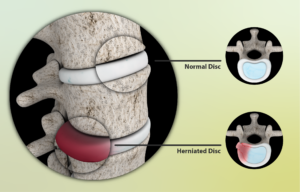Navigating the Maze of Bulging Discs
 Introduction
Introduction
Bulging discs are a common culprit behind back and neck discomfort, leaving many individuals searching for answers and relief. In this article, we’ll explore the mysteries of bulging discs from an applied kinesiology perspective, aiming to provide a fresh take on the subject. While we touch upon the fundamentals of this condition, we’ll emphasize how applied kinesiology can offer innovative insights and potential solutions. Our goal is to empower readers to understand the intricacies of bulging discs and discover a new approach to managing them through applied kinesiology.
Cracking the Code of Bulging Discs
Bulging discs, also known as disc protrusions or herniated discs, occur when the soft inner material of an intervertebral disc pushes against or protrudes through the tougher outer layer. These bulges can press on nearby nerves, leading to symptoms such as pain, numbness, tingling, or weakness in various parts of the body. The causes of bulging discs are diverse, making it a complex condition to diagnose and treat.
A Holistic Perspective
Applied kinesiology (A.K.) offers a unique approach to healthcare that blends elements of chiropractic care, nutrition, and various healing modalities. It is a method to assess the body’s functional and structural imbalances through muscle testing, allowing practitioners to identify and address underlying issues contributing to a patient’s condition. Applied kinesiologists employ manual muscle testing to spot weaknesses or imbalances in specific muscles, striving to uncover the root cause of a patient’s symptoms.
Making Connections: A.K. and Bulging Discs
When it comes to bulging discs, applied kinesiology brings a fresh perspective to the table:
- Muscle Testing: Applied kinesiologists use muscle testing to evaluate the strength and function of the muscles supporting the spine. Weakness or imbalances in these muscles can be key factors in the development or progression of bulging discs.
- Structural Assessment: The alignment of the spine and the pressure on intervertebral discs are pivotal in the development of bulging discs. Applied kinesiology practitioners assess the structural components to determine if misalignments play a role in this condition.
- Nutritional Assessment: Nutrition and dietary imbalances can significantly impact the body’s ability to heal and maintain the health of spinal structures. Applied kinesiology can identify specific nutritional needs to support the healing process.
-
Comprehensive Approach: Applied kinesiology adopts a holistic view of a patient’s health, addressing various aspects of their well-being, including physical, emotional, and nutritional factors.
Conclusion
Bulging discs can be complex and painful, but applied kinesiology brings a unique perspective that helps uncover the root causes and manage this condition. By assessing muscle strength, structural alignment, and nutrition, applied kinesiologists assist patients with bulging discs in finding relief and enhancing their overall well-being.
 True Health | Charleston, WV
True Health | Charleston, WV
Recent Comments